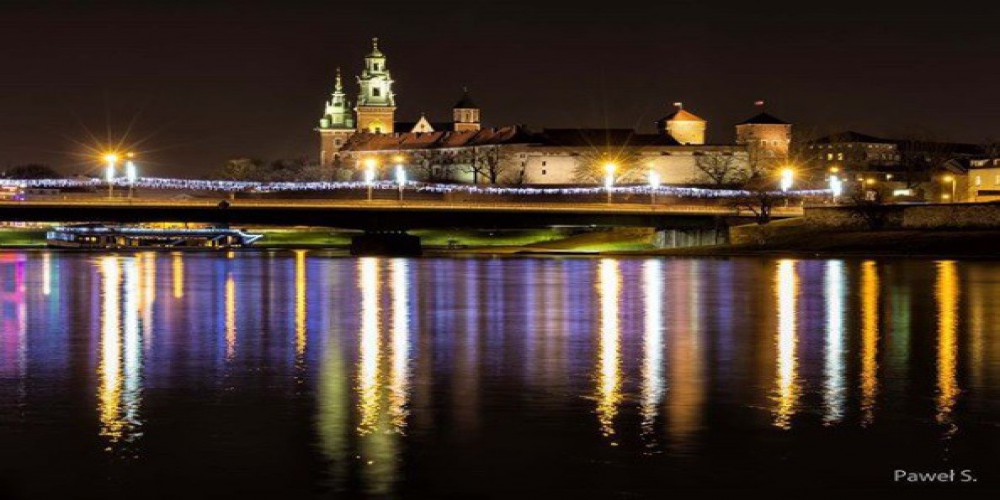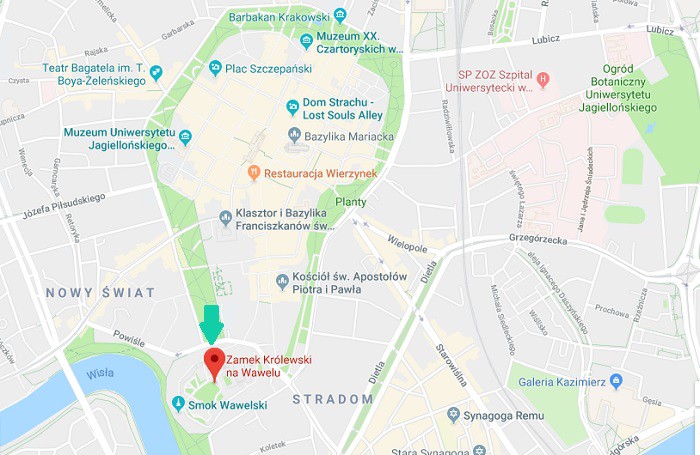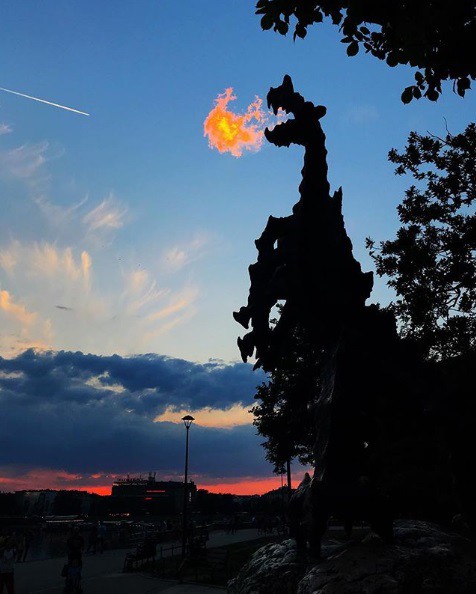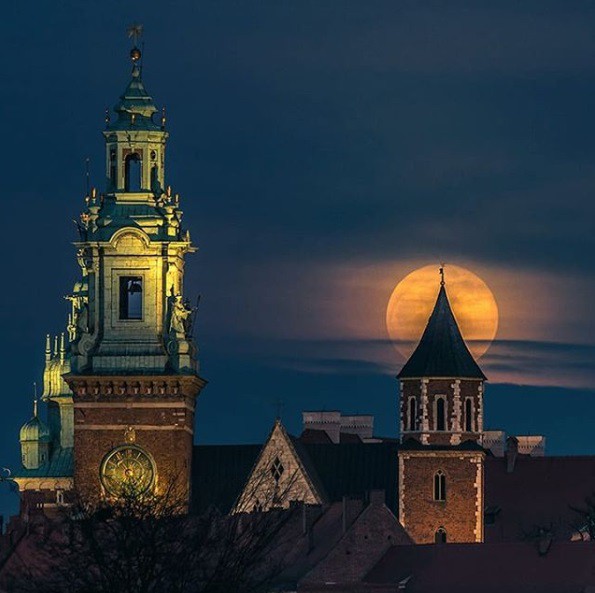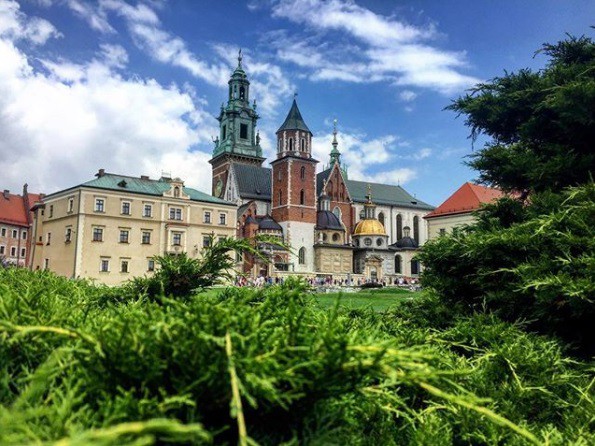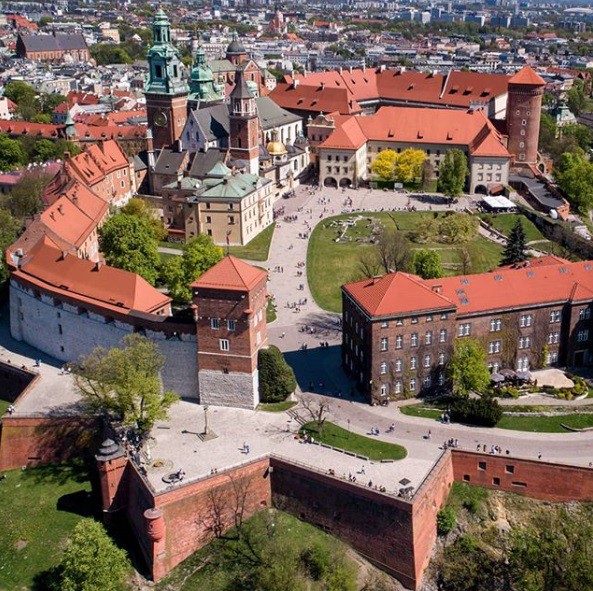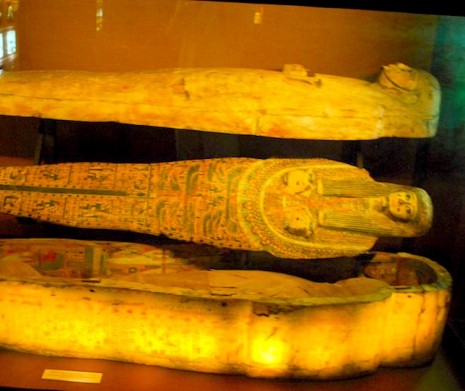Krakow Wawel Castle Facts
All about the legendary, majestic castle in the heart of the city
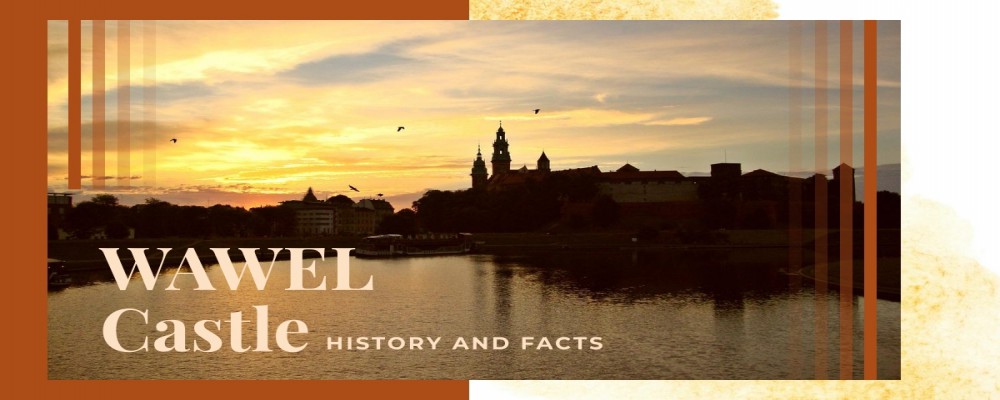
Wawel Castle is one the most famous buildings in Poland.
You know what it looks like, right?
Everyone does.
But do you know the history and legends behind it?
In this article you will find a handful of useful and interesting facts about the Wawel Castle.
Ready to impress your family and friends while sightseeing?
Come on! Let’s go!
And just one more thing: if you are interested in sightseeing of Wawel Castle, here is an offer for you: Wawel Cathedral Ticket ONLINE.
It is the only way you can prebook your ticket online and skip the line!
source: www.instagram.com/siwadlowski
Basic information about the Wawel Castle:
-
Where is Wawel Castle located?
Wawel Castle, built upon the Wawel hill, is located in the very heart of Krakow – just by the Vistula river.
-
How to get to the Wawel Castle?
If you are accommodated in the city centre, there is a solid chance that the castle is within walking distance from you – it takes an approximately 10-15 minute walk from the Main Market Square to get to the castle (via the absolutely gorgeous Grodzka and Kanonicza streets).
When using public transport, you can take a tram and get out at WAWEL stop which is just by the castle. Trams that go there are 6, 8, 10, 13 and 18 (though just to be sure, I highly advise you to check current timetable).
-
'Wawel' – what is the meaning?
We can’t be sure today, but there are a few theories – some of them point to the castle’s location (between swamps) and numerous caves in proximity, others suggest a relation to the biblical Tower of Babel, and there are even ones that claim the name could be tied to... lumps on people’s necks linked to thyroid disease caused by low levels of iodine in local water.
As you can see, not a very coherent story… But hey, at least we tried!
-
When was Wawel Castle built?
The oldest fragments found during archaeological research are dated to the XI century.
The buildings were being rebuilt and new ones were constantly being added so it is impossible to pin down one exact date.
-
How old is the Wawel Castle?
Today, in the XXI century, we can say that the castle is 1000 years old.
Isn’t that crazy?!
-
Who built the Wawel Castle?
We don’t know much about the very first builders (or exact first buildings, for that matter), but the kings that were crucial to Wawel’s development and heyday were Władysław I the Elbow-high (reign: 1306-1333) and Casimir III the Great (reign: 1333-1370).
-
Short description of the Wawel Castle
The Wawel Castle used to be a home and a fortress of Polish kings while Krakow was the capital of the country. It has been a pride of the nation and a symbol of the regnant.
Wawel Castle is one of the most important, the most beautiful, and the biggest Polish castles. Located on a hill, it is a complex of buildings surrounding a majestic yard.
Rebuilt and renovated many times due to fires, thefts and wars, it encompasses many different architectural styles. This incredible diversion lets us leave modern days behind and enter time machine while discovering the castle and admiring it’s striking beauty.
Today the Wawel Castle is a museum in which you can marvel at the highest class works of art – stunning paintings, beautiful scultpures, sophisticated tapestries and many more.
Fun fact – up until recently Da Vinci’s Lady with an ermine was there for a few years – today you can see it in Krakow’s National Museum (which, by the way, is also worth visiting!).
The castle also houses an important art conservation centre.
There is so much to see there!
Did you know…
The Historic Centre of Krakow (including Wawel!) has been enlisted on UNESCO’s World Heritage Sites in 1978?!
History of the Wawel Castle
Let’s begin the jorney through centuries…
You will not get bored.
I promise!
First evidence of settlement
First settlements in the area of today’s Krakow are said to reach back to 200,000 BC.
Wawel Hill (high 228 metres above the sea level) – a limestone Jurrassic hill, was a great strategic spot to settle for the tribes – surrounded by the Vistula river from one side and swamps from another, it was more difficult to attack and easier to defend due to the natural conditions.
The Wawel Hill – Pagans’ Favourite Place in Krakow
At the time, many mounds and kurgans were erected in the area – most presumably due to the early Celtic settlements that adopted Wawel Hill as their central site.
The favourable natural conditions of Lesser Poland (hills, rivers and forests) also attracted the Slavic tribe of Vistulans (likely named after Vistula, largest river of Poland) in the VII-VIII centuries, after the territory had been abandoned due to Hunnic invasions.
It was the Wawel Hill that was chosen to house the mightiest individuals within the tribe. According to an early-medieval legend, the town was established by King Krakus, who was believed to have slayed the Wawel Dragon (the bones of the assumed dragon are displayed at the entry to Wawel Cathedral to this day).
Wawel Dragon – the legend
source: www.instagram.com/life_frames
A long, long time ago, in a dark, cold den at the foot of Wawel hill, there lived a horrifying, blood-curdling dragon (later described as Holofagus, meaning – the one who eats whole) that put fear into hearts of the people who were living there.
The dragon was said to be invincible. People believed that no one could conquer him and that no weapon is powerful enough to kill the beast. Even the bravest of men were trembling with fear when the dragon roared.
The king, frightened for his people, decided to act upon the issue and called for action. He promised to give his sceptre, crown and his daughter’s hand to the hero who could defeat the dragon.
Many valiant knights came from all over the world to try and put an end to the monster’s life, but to no avail – their swords and arrows were breaking on his scales.
Even the most determined daredevils were becoming discouraged and left Krakow defeated by the beast. Less and less men were coming every day to help and the people who lived in Krakow started fleeing the city.
One day a young man named Skuba came and knocked on town gates. No one has ever heard of him or knew who he was. He bore no weapons and wore no armour. He was a shoemaker and the only things he had with him were some yarn and a needle.
When king Krakus had heard the idea of the boy, he decided to trust him and let him try to conquer the dragon. Skuba requested a skin of a lamb and some sulphur.
He was preparing his plan for the entire night. He filled the lambskin with sulphur, sewed it up and brought it to the dragon’s den.
The next morning the dragon woke up hungry. Luckily (or so he thought), an easy meal was lying at his doorstep.
The beast ate the lamb and the sulphur made his throat burn so much that he started gulping water from the river. He couldn’t stop drinking, and – in effect – drank too much and burst from the water!
The dragon was dead, the peace was restored and the people were happy again.
What a cool story, huh?
Today the dragon is commemorated by a statue that breathes real fire. You can also visit the dragon’s den (travel tip: it gets quite chilly there! Take something warm to wear with you).
And if you would like to see how the Wawel Dragon is breathing REAL fire check out our blog post dedicated entirely to Wawel Dragon and it’s legend.
Did you know…
Some people assign magical properties to the hill – they say that Wawel Chakra is responsible for a flow of unique energy there and they come a long way to visit the area for spiritual reasons. Centre of said energy is supposedly located under one of the oldest parts of the Castle – st. Gereon’s chapel located in the north-west corner of the Wawel’s courtyard.
Krakow – the capital of Poland
After Krakow was chosen as the capital of Poland, a stone Romanesque cathedral was erected on Wawel Hill – the most prominent place of the area.
The second building appeared there in the XII century.
The first historical coronation of a Polish ruler was held in Krakow in 1320.
Throughout his reign, a third cathedral started being built to adopt a Gothic shape. The adjoining castle was being expanded and additionally fortified.
Throughout its history, Wawel served as a residence for monarchs and people of importance, this is why there are 12 unique state rooms.
source: www.instagram.com/nathaliec136
The golden age of the Wawel Castle
Wawel Castle became the main residence of Polish royalty, with many private rooms designated for them, for a long time to come.
The largest expansion of Gothic and brick-made part of Wawel Castle could happen due to the decisions of Casimir III the Great (1333-1370).
His successors, king Ladislas Jagiello and his wife, Jadviga of Andegavens, invited numerous artists and architects to Wawel Castle – this is when the structure was enriched with the Thieve’s, Sandomierz and Senatorial Towers.
The cathedral (Wawel Cathedral) also has its own towers, with Zygmuntowska tower having 5 bells, of which the largest one weighs 11000 kg.
In the XVI entury, the famous arcaded courtyard of Wawel was constructed, along with the Renaissance castle to replace the Gothic one.
source: www.instagram.com/andgphotos
The most popular choices
Renovations, renovations…
The Italian architects and artists who were commissioned the works have also contributed to the erection of the massive Sigismund chapel at Wawel Hill.
Up to the reign of Sigismund II Augustus (1548-1572), Wawel Castle would be where the foremost treasures and masterpieces of art, precious tapestries, gobelins, goldsmith’s work and statues were stored.
With Sigismund III Vasa coming to power, there would only be one Baroque wing built to replace a burnt part of the castle. Wawel became a treasury for art of historical significance.
Wawel Castle under the occupation
Later, as the capital was moved to Warsaw and Poland lost its independence, Wawel would serve as a citadel for the Austro-Hungarian army. Certain parts (e.g. churches) were demolished by the new administrators.
During WW II Wawel has become a private residence of Nazi officials of the General Government established in this part of occupied country.
In the second part of the 20th century, Wawel became restored and started having most of its chambers and buildings open to the public. Its rich interiors, art and military collection, as well as impressive fortifications are real must-sees while visiting Krakow.
source: www.instagram.com/ro.abrines
Did you know…
You can find a bit of Wawel Castle in the United States?!
A fragment of column from the castle has been incorporated into Tribune Tower in Chicago as a tribute to large Polish minority in Chicago, which is the largest Polish presence outside Poland!
Wawel Castle Tickets
Hopefully you are alredy convinced to visit Wawel Castle.
But you must be wondering how to do so?
There are several options:
- You can simply go the Wawel Castle Hill and take a walk around without any guide or tickets (it will be a pleasurable walk, but you will not see the most important things – the inside of the Castle!)
- You can go to the Wawel Hill and buy a ticket for sightseeing there – unfortunately this is the most popular option, and lots (LOTS!) of tourists decide to do so. That’s why the queue to the ticket booth is quite overwhelming.
- You can prebook your ticket for the Wawel Hill Guided Tour – you will have to pay in advanced BUT your seat will be secured and you will avoid this awful queue to the ticket booth! You will thank yourself for making that smart decision ahead of time :)
Wawel Castle – today
You may be wondering – what does the castle mean to contemporary Poles and how is it important to them?
- It is an iconic symbol of Polish history that is also a work of art in itself.
- It is a great place to spend a chill afternoon overlooking Vistula and the city.
- It is a cathedral which is an important place of worship for many people.
- It houses a vast collection of significant, precious objects that help us understand and appreciate our culture.
- It is a national treasure and pride.
And for you… after reading this article, it may become a great conversation piece :)
(Also, see for yourself just how incredibly insta-friendly that place is. WOW!)
source: www.instagram.com/polskazachwyca
I hope that this article has made you interested in Wawel. It’s a place with long history and picturesque sights.
Why not pay it a visit while wandering around Krakow? It will certainly impress you and become a memorable part of your trip.
There is no entrance fee to the Hill and general premises, but if you want to visit the museum, you have to purchase a ticket.
You can also attend a guided tour, which will allow you to immerse yourself even more in the stories and secrets of the Wawel Castle, it’s former inhabitants and it’s rocky past.
See you there!
